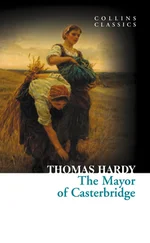THE RETURN OF THE NATIVE
Thomas Hardy
Table of Contents
Title Page THE RETURN OF THE NATIVE Thomas Hardy
History of Collins
Life & Times
PREFACE
BOOK ONE—THE THREE WOMEN
Chapter 1: A Face on Which Time Makes but Little Impression
Chapter 2: Humanity Appears upon the Scene, Hand in Hand with Trouble
Chapter 3: The Custom of the Country
Chapter 4: The Halt on the Turnpike Road
Chapter 5: Perplexity among Honest People
Chapter 6: The Figure against the Sky
Chapter 7: Queen of Night
Chapter 8: Those Who Are Found Where There Is Said to Be Nobody
Chapter 9: Love Leads a Shrewd Man into Strategy
Chapter 10: A Desperate Attempt at Persuasion
Chapter 11: The Dishonesty of an Honest Woman
BOOK TWO—THE ARRIVAL
Chapter 1: Tidings of the Comer
Chapter 2: The People at Blooms-End Make Ready
Chapter 3: How a Little Sound Produced a Great Dream
Chapter 4: Eustacia Is Led on to an Adventure
Chapter 5: Through the Moonlight
Chapter 6: The Two Stand Face to Face
Chapter 7: A Coalition between Beauty and Oddness
Chapter 8: Firmness Is Discovered in a Gentle Heart
BOOK THREE—THE FASCINATION
Chapter 1: “My Mind to Me a Kingdom Is”
Chapter 2: The New Course Causes Disappointment
Chapter 3: The First Act in a Timeworn Drama
Chapter 4: An Hour of Bliss and Many Hours of Sadness
Chapter 5: Sharp Words Are Spoken, and a Crisis Ensues
Chapter 6: Yeobright Goes, and the Breach Is Complete
Chapter 7: The Morning and the Evening of a Day
Chapter 8: A New Force Disturbs the Current
BOOK FOUR—THE CLOSED DOOR
Chapter 1: The Rencounter by the Pool
Chapter 2: He Is Set upon by Adversities but He Sings a Song
Chapter 3: She Goes Out to Battle against Depression
Chapter 4: Rough Coercion Is Employed
Chapter 5: The Journey across the Heath
Chapter 6: A Conjuncture, and Its Result upon the Pedestrian
Chapter 7: The Tragic Meeting of Two Old Friends
Chapter 8: Eustacia Hears of Good Fortune, and Beholds Evil
BOOK FIVE—THE DISCOVERY
Chapter 1: “Wherefore Is Light Given to Him That Is in Misery”
Chapter 2: A Lurid Light Breaks in upon a Darkened Understanding
Chapter 3: Eustacia Dresses Herself on a Black Morning
Chapter 4: The Ministrations of a Half-forgotten One
Chapter 5: An Old Move Inadvertently Repeated
Chapter 6: Thomasin Argues with Her Cousin, and He Writes a Letter
Chapter 7: The Night of the Sixth of November
Chapter 8: Rain, Darkness, and Anxious Wanderers
Chapter 9: Sights and Sounds Draw the Wanderers Together
BOOK SIX—AFTERCOURSES
Chapter 1: The Inevitable Movement Onward
Chapter 2: Thomasin Walks in a Green Place by the Roman Road
Chapter 3: The Serious Discourse of Clym with His Cousin
Chapter 4: Cheerfulness Again Asserts Itself at Blooms-End, and Clym Finds His
Footnotes
Classic Literature: Words and Phrases adapted from the Collins English Dictionary
Copyright
About the Publisher
In 1819, millworker William Collins from Glasgow, Scotland, set up a company for printing and publishing pamphlets, sermons, hymn books and prayer books. That company was Collins and was to mark the birth of HarperCollins Publishers as we know it today. The long tradition of Collins dictionary publishing can be traced back to the first dictionary William published in 1824, Greek and English Lexicon . Indeed, from 1840 onwards, he began to produce illustrated dictionaries and even obtained a licence to print and publish the Bible.
Soon after, William published the first Collins novel, Ready Reckoner , however it was the time of the Long Depression, where harvests were poor, prices were high, potato crops had failed and violence was erupting in Europe. As a result, many factories across the country were forced to close down and William chose to retire in 1846, partly due to the hardships he was facing.
Aged 30, William’s son, William II took over the business. A keen humanitarian with a warm heart and a generous spirit, William II was truly ‘Victorian’ in his outlook. He introduced new, up-to-date steam presses and published affordable editions of Shakespeare’s works and The Pilgrim’s Progress , making them available to the masses for the first time. A new demand for educational books meant that success came with the publication of travel books, scientific books, encyclopaedias and dictionaries. This demand to be educated led to the later publication of atlases and Collins also held the monopoly on scripture writing at the time.
In the 1860s Collins began to expand and diversify and the idea of ‘books for the millions’ was developed. Affordable editions of classical literature were published and in 1903 Collins introduced 10 titles in their Collins Handy Illustrated Pocket Novels. These proved so popular that a few years later this had increased to an output of 50 volumes, selling nearly half a million in their year of publication. In the same year, The Everyman’s Library was also instituted, with the idea of publishing an affordable library of the most important classical works, biographies, religious and philosophical treatments, plays, poems, travel and adventure. This series eclipsed all competition at the time and the introduction of paperback books in the 1950s helped to open that market and marked a high point in the industry.
HarperCollins is and has always been a champion of the classics and the current Collins Classics series follows in this tradition – publishing classical literature that is affordable and available to all. Beautifully packaged, highly collectible and intended to be reread and enjoyed at every opportunity.
Life & Times
About the Author
Thomas Hardy was born in a Dorset village in 1840. Although he had a modest upbringing, Hardy found himself working successfully as an architect in London at the age of 22. He spent five years in London, but was eventually drawn back to Dorset because he did not enjoy the urban environment or the class prejudice he felt, mixing with the well-heeled of England’s capital city. Having returned to the countryside, he began to consider an alternative career as a novelist. By 1867 he had already completed a manuscript, but had no luck placing it with a publisher. Despite this, his ambition knew no bounds and he persevered securing his first publication in 1871. His first five novels were well received and Hardy’s confidence in pushing the literary envelope grew steadily.
Most of Hardy’s work is set in a semi-fictional region called Wessex. The name comes from the Anglo-Saxon Kingdom of Wessex, which was eventually fragmented following the invasion of William the Conqueror in 1066. In his imaginary Wessex, Hardy gives many real places alternative names as if it were a kind of parallel universe. This was Hardy’s devise, partly to make it abundantly clear that his work was not about real people and places, but also to provide a world into which he could escape as a writer.
In Far From the Madding Crowd , published in serial form in 1874, Bathsheba is his beautiful female protagonist and it is through her experiences that Hardy exposes his feelings on romantic love and the inconsistency and destruction that can be caused by relationships. However, the central concern of Far From the Madding Crowd highlights Hardy’s preoccupation with the modernity and industrialization of society. Many of his texts are set in rural locations and Hardy details the dialects, landscape, and people of the English countryside to try and preserve that history and endangered way of life. Central to Hardy’s overall ambition was to show that living people are only ever custodians of the world for future generations. Dorset is filled with ancient sites of human activity and prehistoric evidence of a past without humanity. Hardy wanted to make it clear that we each have a window of opportunity in life to make our mark. That is why he had little time for people whom he considered to be fatuous or self-interested, because he was acutely aware that it is the impression that we make on others that counts the most, both during life and after death.
Читать дальше












